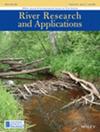沿海切喉鳟产卵栖息地 PHABSIM 建模替代方法评估
IF 1.9
4区 环境科学与生态学
Q4 ENVIRONMENTAL SCIENCES
引用次数: 0
摘要
面对不断变化的气候和人类对水资源日益增长的需求,了解栖息地的偏好对于管理野生鱼类种群以及预测栖息地和种群的潜在变化至关重要。对沿海切喉鳟产卵栖息地物理栖息地模拟(PHABSIM)的两种建模方法进行了比较,方法是用两组栖息地变量对普吉特海湾一条小溪的一个河段进行建模,该河段由八个横断面组成,涵盖一个水池和上下游溪流。根据多年的红点调查,该河段连续两年出现红点群,被认为是首选产卵栖息地的标志,且位于该流域产卵量最大的区域。在研究地点建立了两个 PHABSIM 流模型,一个是基于标准微生境(深度[D]、流速[V]和底质[S])适宜性的模型,另一个是基于 D、V 和河道单元(CU)适宜性的模型,并比较了它们在正确预测 PHABSIM 研究地点红点处沿岸切喉鳟产卵生境选择方面的相对能力。一种方法是标准使用 D、V 和 S 的生境适宜性标准 (HSC) 来表示产卵生境的质量。另一种方法是用 CU 指数 HSC 取代底质 HSC,CU 指数 HSC 包括主要底质颗粒直径、CU(裂谷、深浅潭尾、潭体、深浅潭边、梯级、瀑布和陆地),其中深浅单位基于相对剩余深度 (RRD)、CU 相对于河道宽度的大小以及在 CU 中的位置。每个断面的产卵栖息地质量都是根据标准 HSC 指标(WUWs)和修正的 CU 指数(WUWm)加权可用宽度计算得出的。在包围红点群的横断面上,加权可用宽度(WUWm)超过了其余六个横断面上的加权可用宽度(WUWm),并且超出了其余横断面上加权可用宽度(WUWm)的 95% 置信区间。相比之下,红点群与其余横断面之间的 WUWs 变化较小,表明 CU 指数比底质更能反映产卵栖息地的质量。相对于 SZF 的海拔高度可解决孵化期间易受流量下降影响的问题。这两个模型都得出了斯库克姆溪中与大多数新鲜切喉鳟红点相吻合的排水量范围内的最大 WUA。本文章由计算机程序翻译,如有差异,请以英文原文为准。
Evaluation of alternative approaches to PHABSIM modeling of coastal cutthroat trout spawning habitat
In the face of a changing climate and increasing human demand for water, an understanding of habitat preference has become critical for managing wild fish populations and projecting potential changes in habitat and populations. Two approaches to Physical Habitat Simulation (PHABSIM) modeling of coastal cutthroat trout Oncorhynchus clarkii clarkii spawning habitat were compared by modeling a reach, consisting of eight transects covering a pool and upstream and downstream riffles, of a small Puget Sound stream with two sets of habitat variables. The reach contained a cluster of redds 2 years in a row, assumed to be an indication of preferred spawning habitat and was located in the area of maximum spawning in the watershed, based on multiple years of redd surveys. Two PHABSIM instream flow models of the study site, one based on standard microhabitat (depth [D], velocity [V], and substrate [S]) suitabilities and the other based on D, V, and channel unit (CU) suitabilities, were developed and compared for their relative ability to correctly predict coastal cutthroat trout spawning habitat selection at the redd cluster within the PHABSIM study site. One approach was the standard use of habitat suitability criteria (HSC) for D, V, and S to indicate spawning habitat quality. The alternate approach was to replace substrate HSC with CU index HSC that incorporated dominant substrate particle diameter, CU (riffle, deep and shallow pool tail, pool body, deep and shallow pool edge, cascade, waterfall, and terrestrial), where deep and shallow units were based on relative residual depth (RRD), size of CU relative to channel width, and position within CU. Spawning habitat quality was calculated for each transect as weighted usable width with the standard HSC metrics (WUWs) as well as the modified CU index (WUWm). WUWm at the transects bracketing the redd cluster exceeded WUWm at the remaining six transects and was outside the 95% confidence interval for WUWm at the remaining transects. In contrast, WUWs varied less between the redd cluster and the remainder of the transects, suggesting the CU index better reflected spawning habitat quality than substrate. Incorporation of elevation relative to SZF addressed vulnerability to declining flow during incubation. Both models resulted in maximum WUA within the range of discharges that coincided with the majority of fresh cutthroat trout redds in Skookum Creek.
求助全文
通过发布文献求助,成功后即可免费获取论文全文。
去求助
来源期刊

River Research and Applications
环境科学-环境科学
CiteScore
4.60
自引率
9.10%
发文量
158
审稿时长
6 months
期刊介绍:
River Research and Applications , previously published as Regulated Rivers: Research and Management (1987-2001), is an international journal dedicated to the promotion of basic and applied scientific research on rivers. The journal publishes original scientific and technical papers on biological, ecological, geomorphological, hydrological, engineering and geographical aspects related to rivers in both the developed and developing world. Papers showing how basic studies and new science can be of use in applied problems associated with river management, regulation and restoration are encouraged as is interdisciplinary research concerned directly or indirectly with river management problems.
 求助内容:
求助内容: 应助结果提醒方式:
应助结果提醒方式:


